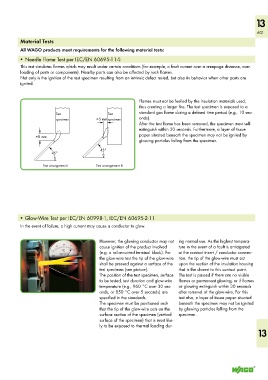Page 603 - Wago_PCB_TerminalBlocksConnectors_Volume2_2015_US
P. 603
13
601
Material Tests
All WAGO products meet requirements for the following material tests:
• Needle Flame Test per IEC/EN 60695-11-5
This test simulates flames which may result under certain conditions (for example, a fault current over a creepage distance, over-
loading of ports or components). Nearby parts can also be affected by such flames.
Not only is the ignition of the test specimen resulting from an intrinsic defect tested, but also its behavior when other parts are
ignited.
Flames must not be fuelled by the insulation materials used,
thus creating a larger fire. The test specimen is exposed to a
Test Test standard gas flame during a defined time period (e.g., 10 sec-
specimen specimen onds).
<_ After the test flame has been removed, the specimen must self-
≈5 mm <_
<_ extinguish within 30 seconds. Furthermore, a layer of tissue
≈8 mm paper situated beneath the specimen may not be ignited by
glowing particles falling from the specimen.
<_
45°
45°
Test arrangement I Test arrangement II
• Glow-Wire Test per IEC/EN 60998-1, IEC/EN 60695-2-11
In the event of failure, a high current may cause a conductor to glow.
However, the glowing conductor may not ing normal use. As the highest tempera-
cause ignition of the product involved ture in the event of a fault is anticipated
(e.g. a rail-mounted terminal block). For at the contact insert / conductor connec-
the glow-wire test the tip of the glow-wire tion, the tip of the glow-wire must act
shall be pressed against a surface of the upon the section of the insulation housing
test specimen (see picture). that is the closest to this contact point.
The position of the test specimen, surface The test is passed if there are no visible
to be tested, test duration and glow-wire flames or permanent glowing, or if flames
temperature (e.g., 960 °C over 30 sec- or glowing extinguish within 30 seconds
onds, or 850 °C over 5 seconds) are after removal of the glow-wire. For this
specified in the standards. test also, a layer of tissue paper situated
The specimen must be positioned such beneath the specimen may not be ignited
that the tip of the glow-wire acts on the by glowing particles falling from the
surface section of the specimen (vertical specimen.
surface of the specimen) that is most like-
ly to be exposed to thermal loading dur-
13

